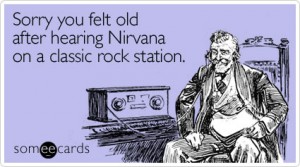 As a solid Generation Xer from the college radio cohort I remember quite clearly the alternative rock craze of the 1990s. In the wake of Nirvana’s breakthrough on the top 40, followed by fellow Seattle bands like Pearl Jam and Soundgarden, major labels went on a signing spree looking for any band with a smidge of underground cred or at least an “alternative” look and sound. Radio followed in this wake as the word “alternative” became both a format and a genre, albeit one with very fuzzy margins.
As a solid Generation Xer from the college radio cohort I remember quite clearly the alternative rock craze of the 1990s. In the wake of Nirvana’s breakthrough on the top 40, followed by fellow Seattle bands like Pearl Jam and Soundgarden, major labels went on a signing spree looking for any band with a smidge of underground cred or at least an “alternative” look and sound. Radio followed in this wake as the word “alternative” became both a format and a genre, albeit one with very fuzzy margins.
But the crisis of creativity in commercial radio brought on by industry consolidation and the debt crisis helped take the wind out of the alternative sails, as stations dropped the format, or it mutated into something much more like classic rock for thirty-somethings.
However, according to Sean Ross at Edison Research, alternative rock radio that is actually kind of, er, “alternative,” is making a comeback, sort of. He notes hearing more new “true.alt” songs from artists like the Neighbourhood coming up in rotation on stations like Los Angeles’ KROQ, nestled between tried and true 90s alternative radio classics. On top of that Ross says that sometimes he hears these “currents” in radio jargon being played back-to-back, which further indicates program directors’ faith in adding new bands and tracks.
At the same time, Ross notes that only 21 out of Arbitron’s 48 people-meter markets have a rock station in the top 10 that isn’t a classic rocker. He also observes that many of the successful stations are ones “that never fell apart during the worst of the format doldrums.”
Ultimately, Ross concludes, avoiding commitment, “At this moment, the ‘comeback’ is far along enough that it should neither be confirmed nor rebutted.”
When it comes to innovation in new rock music, I can fully commit to saying that non-commercial stations are eating commercial stations’ lunches. Seattle’s KEXP and Minnesota Public Radio’s The Current are two stations that program a wide variety of cutting-edge rock and pop music, with a tighter playlist and schedule than a college or community station. Now, it must also be acknowledged that KEXP comes in #26 in that market’s ratings, while The Current sits at #16. Of course, both stations probably spend a lot less on promotion that a commercial alternative station, and are less dependent on ratings success, too.
Another crucial difference is that KEXP and The Current are both very popular online. I don’t have any statistics on hand to back me up, but I’m guessing that both stations are more popular online than your average local commercial alternative, due to each having a distinct identity and national reputation. Although erstwhile well-known stations like KROQ may be competitive in that arena.
I’m sure it’s obvious that my own preference leans towards non-commercial stations that take more risks, whether they’re the kind of calculated risks that KEXP and the Current made, or the freeform experimentation of college and community stations. But there is a place for well-formatted commercial alternative stations, too, that balance the cutting edge with more familiar recent and older tracks. Sometimes I want to hear the alternative hits of the 90s and 00s alongside something current and unknown, and I’d be glad to have a good commercial station deliver that listening experience.
More than a comeback of commercial alternative radio I’d like to see a renaissance, picking up where some of the more innovative stations of the past left off (see WOXY), and crafting something new for the 2010s. I’d love to hear something more than just a couple “currents” dropped into an hour of broadcast.
Unfortunately, I suspect that may be too much to ask.


